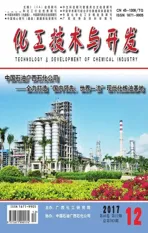短程硝化反硝化生物脱氮研究现状
2017-03-03胡筱敏李国德刘金亮于洪军
李 娜,胡筱敏,李国德,刘金亮,于洪军
( 1东北大学资源与土木工程学院,辽宁 沈阳 110004;2.沈阳师范大学实验教学中心,辽宁 沈阳 110034;3.法库县辽河保护区管理局,辽宁 沈阳 110400)
短程硝化反硝化生物脱氮研究现状
李 娜1,2,胡筱敏1,李国德2,刘金亮1,于洪军3
( 1东北大学资源与土木工程学院,辽宁 沈阳 110004;2.沈阳师范大学实验教学中心,辽宁 沈阳 110034;3.法库县辽河保护区管理局,辽宁 沈阳 110400)
1975年Voet发现了在硝化过程中亚硝氮积累的现象,首次提出了短程硝化反硝化生物脱氮理论,1986年Sutherson等证实了短程硝化的可行性。相比于传统硝化反硝化工艺,短程硝化反硝化可减少需氧量和有机碳源,缩短系统水力停留时间,降低污水处理运行费用和基建投资等。鉴于短程硝化反硝化的诸多优点,该工艺引起了污水处理领域的广泛关注,本文对短程硝化反硝化的原理、优点以及国内外应用现状进行了简要概述。
短程硝化反硝化;脱氮;研究现状
伴随着对生物脱氮理论更深层次的研究,研究者们发现了一系列超出对传统生物脱氮理论认识的奇怪现象,如某些微生物可以在好氧条件下进行反硝化[1-2],除了自养菌外,异氧菌也能够参与硝化反应[3-4],已有研究者在厌氧反应器中发现了氨氮减少的现象[5-6]。这些新奇的现象为研究者们提供了新的研究理论和新的研究思路,新的生物脱氮理论也由此而被发现,短程硝化反硝化工艺就是其中之一。
1 短程硝化反硝化生物脱氮原理及优点
短程硝化反硝化相比于全程硝化反硝化,缩短了反应步骤,正是由于生物脱氮过程中反应步骤的减少,使短程硝化反硝化具有如下优势[7-8]:
1)可减少约25%的需氧量,降低了污水处理的运行能耗;2)可减少40%左右的有机碳源,降低污水处理运行费用;3)缩短了系统的水力停留时间,减小了反应器有效容积,节省了污水处理基建投资;4)减少剩余污泥的排放量,节省了污水处理中的污泥处理费用;5)减少了碱的投加量,运行管理简单。
2 短程硝化反硝化国内外的应用现状
王江宽[9]采用SBR反应器研究了非单一因素控制条件下短程硝化反硝化系统的稳定性。结果表明,升高温度可促进低DO和SRT条件下短程硝化反硝化的实现,同时,该研究提高了系统有机物的去除效率,扩大了实现短程硝化反硝化的DO范围,表明高pH值和适宜SRT有利于短程硝化反硝化的实现和稳定运行。
O.Canals等[10]将微生物群落作为短程生物脱氮的性能指标进行了研究,确定了包含纤毛虫、鞭毛虫、变形虫和线虫的近20个属。与常规废水处理工艺相比,该过程可以定义为具有多样性纤毛虫的鞭毛虫主导系统,鞭毛虫在混合液中占主导地位,表现出对氨较高的耐受性,以及在缺氧条件下长时间存活的能力。实验结果表明,Epistylis cf. rotans可以作为系统硝化过程很好的生物指示剂。该论文对污水处理厂微生物群落的物种生态学及其在污水处理厂的作用进行研究,并提出新的生物管理工具。
Dong Wei等[11]在环境温度下应用SBR工艺研究了进水氨氮浓度对完全硝化转化为短程硝化的影响。经过150d的实验,进水氨氮浓度为400mg·L-1和720mg·L-1时,分别实现了全程硝化和短程硝化。与此同时,污泥容积指数从127.4mL·g-1逐渐降至63.4mL·g-1,而污泥的平均粒径由29.5μm提高到了195.6μm。根据荧光原位杂交分析,氨氧化菌(AOB)是主要的硝化细菌,表明系统中的游离氨(FA)和游离亚硝酸(FNA)抑制了亚硝酸盐氧化细菌(NOB)的活性。该研究结果有助于促进生物脱氮新工艺特别是高氨氮废水处理新工艺的发展。
Qingming He等[12]利用耦合短程硝化反硝化和同时产甲烷反硝化工艺,对畜禽粪便废水的处理进行了研究。实验表明,当厌氧反应器中进水COD负荷为3kg·m-3·d-1、COD/大于30时,COD和的去除效果最佳,当pH和游离氨分别超过8.0和18mg·L-1时,采用短程硝化反硝化有利于处理高浓度畜禽粪便废水,COD、氨氮、总氮的平均去除率以及亚硝氮积累率分别为96.7%、94.9%、86.5%和94.55%。研究表明,采用SMD-SND偶联技术处理高浓度氮和有机物的畜禽粪便废水在技术上是可行的。
3 结语
鉴于短程硝化反硝化相比于全程硝化反硝化的诸多优势,短程硝化反硝化应用于污水处理,在经济和技术方面都具有非常高的可行性,适用于高效、低耗的污水处理目标,具有非常好的应用前景。
[1] Mia Kim, Seong-Yun Jeong, Su Jeong Yoon, et al. Aerobic Denitrification of Pseudomonas putida AD-21 at Different C/N Ratios[J]. Journal of Bioscience and Bioengineering,2008,106(5): 498-502.
[12] L.A. ROBERTSOW, R. CORNELISSE, P. DE VOS, et al.Aerobic denitrification in various heterotrophic nitrifiers [J].Antonie van Leeuwenhoek,1989, 56: 289-299.
[3] Zhiyi Sun, Yongkang Lv, Yuxiang Liu, et al. Removal of nitrogen by heterotrophic nitrification-aerobic denitrification of a novel metal resistant bacterium Cupriavidus sp. S1[J].Bioresource Technology,2016, 220: 142-150.
[4] Wenjie Wan, Donglan He, Zhijun Xue, et al. Removal of nitrogen and phosphorus by heterotrophic nitrificationaerobic denitrification of a denitrifying phosphorusaccumulating bacterium Enterobacter cloacae HW-15 [J].Ecological Engineering, 2017, 99: 199-208.
[5] Marc Strous, Eric Pelletier, Sophie Mangenot, et al.Deciphering the evolution and metabolism of an anammox bacterium from a community genome [J]. Nature, 2006, 440:790-794.
[6] Marc Strous, Eric Pelletier, Sophie Mangenot, et al. Modeling of anammox process with the biowin software suite [J].Applied Biochemistry and Microbiology, 2017, 53(1): 78-84.
[7] Liqiu Zhang, Chaohai Wei, Kefang Zhang, et al. Effects of temperature on simultaneous nitri fi cation and denitri fi cation via nitrite in a sequencing batch bio fi lm reactor [J].Bioprocess Biosyst Eng, 2009, 32: 175-182.
[8] Xiaolian Wang,Yong Ma,Yongzhen Peng, et al. Short-cut nitrifi cation of domestic wastewater in a pilot-scale A/O nitrogen removal plant [J]. Bioprocess Biosyst Eng, 2007, 30: 91-97.
[9] 王江宽.控制DO和SRT条件下短程硝化反硝化及系统稳定性研究[D].青岛:青岛大学,2011.
[10] O.Canals, H.Salvado, M.Auset, et al. Microfauna communities as performance indicators for an A/O Shortcut Biological Nitrogen Removal moving-bed biofilm reactor[J]. Water Reserch, 2013, 47: 3141-3150.
[11] Dong Wei, Xiaodong Xue, Liangguo Yan, et al. Effect of influent ammonium concentration on the shift of full nitritation to partial nitrification in a sequencing batch reactor at ambient temperature[J]. Chemical Engineering Journal, 2014, 235: 19-26.
[12] Qingming He, Xuya Peng, Zhiyang Li. The treatment of animal manure wastewater by coupled simultaneous methanogenesis and denitrification (SMD) and shortcut nitrification–denitrification (SND)[J]. J.Chem. Technol.Biotechnol., 2014, 89: 1697-1704.
Current Research Status of Biological Nitrogen Removal by Shortcut Nitrification and Denitrification
LI Na1,2, HU Xiaomin1, LI Guode2, LIU Jinliang1, YU Hongjun3
(1. School of Resources and Civil Engineering, Northeastern University, Shenyang 110004, China; 2. Experimental Center of Shenyang Normal University, Shenyang 110034, China; 3. Faku County Liaohe Nature Reserve Administration Bureau, Shenyang 110400, China)
In 1975, Voet discovered the phenomenon of nitrite accumulation during nitri fi cation. For the fi rst time, the theory of shortcut nitri fi cation and denitri fi cation was studied. In 1986, Sutherson con fi rmed the feasibility of shortcut nitri fi cation. Compared with the traditional nitri fi cation and denitri fi cation process, shortcut nitri fi cation and denitri fi cation could reduce the oxygen demand and organic carbon source, shorten the system hydraulic retention time, reduce the sewage treatment costs and infrastructure investment. In view of the many advantages of shortcut nitri fi cation and denitri fi cation, this process had aroused widespread concern in the fi eld of wastewater treatment. In this paper, the principle, advantages and current research status of shortcut nitri fi cation and denitri fi cation were brie fl y summarized.
shortcut nitri fi cation and denitri fi cation; nitrogen removal; current research status
X 703.1
A
1671-9905(2017)12-0041-02
水体污染控制与治理科技重大专项( 2013ZX07202-010-02);辽宁省自然科学基金项目(201602683);辽宁省教育厅一般项目(L2014437);沈阳市科技计划项目(F15-199-1-21)
胡筱敏(1958-),男,江西人,教授,博士生导师,从事环境工程与水处理技术研究。E-mail: hxmin_jj@163.com
2017-09-28
